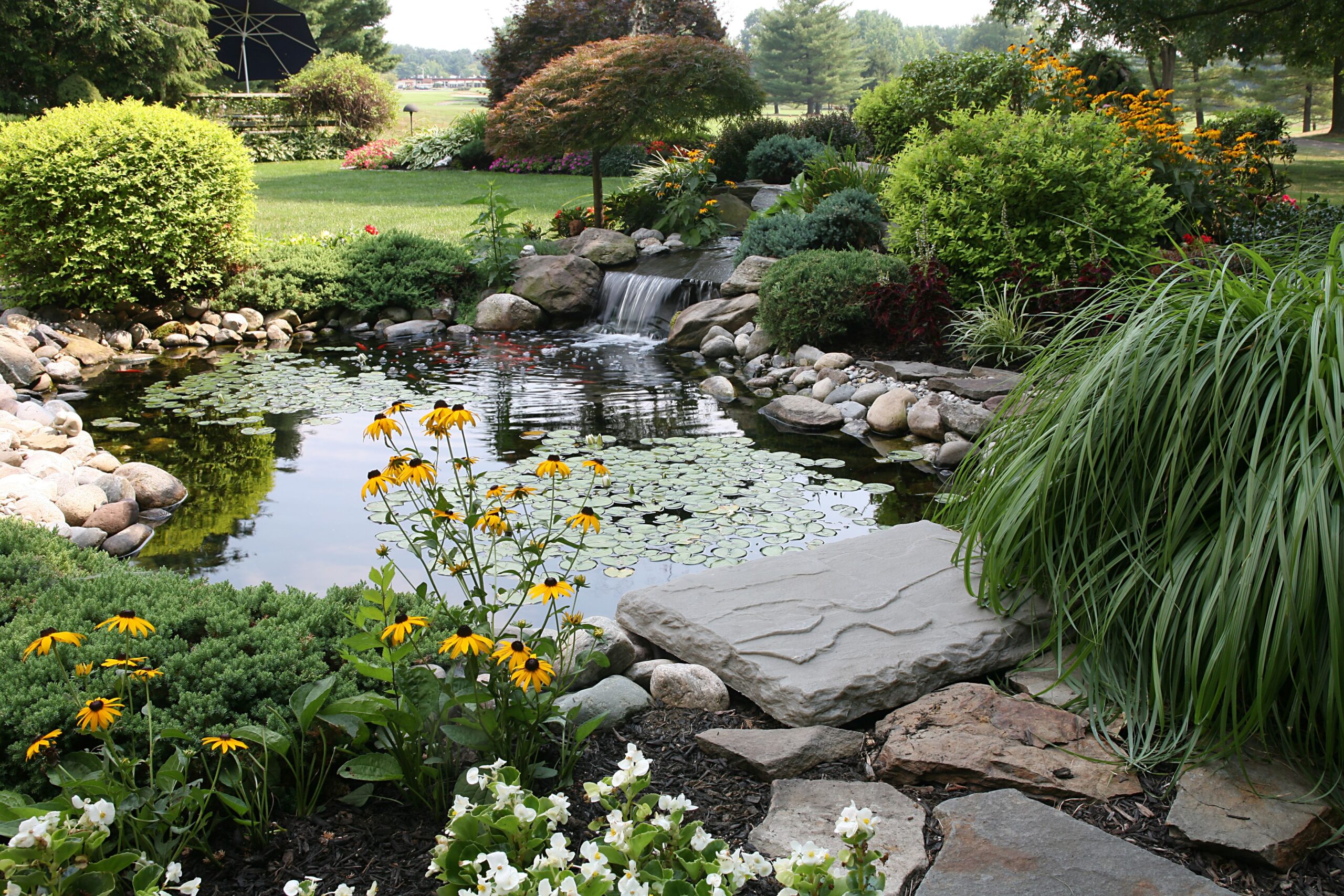Contents
Introduction to Building a Pond
Ponds epitomize natural beauty and tranquility, serving as captivating focal points in gardens, landscapes, and outdoor spaces. Whether nestled amidst verdant foliage or reflecting the azure skies above, ponds evoke a sense of serenity and harmony with nature. Beyond their aesthetic allure, ponds also foster biodiversity, providing habitats for diverse plant and animal species while enhancing the ecological balance of their surroundings.
In the realm of landscape design, the construction of a pond represents a transformative endeavor, offering myriad opportunities for creativity, self-expression, and environmental stewardship. From the tranquil ripples of a reflective surface to the vibrant hues of aquatic flora, ponds beckon us to immerse ourselves in the wonders of the natural world and forge deeper connections with our outdoor environments.
Building a pond is not merely an act of construction but a journey of discovery—an exploration of the interplay between land and water, form and function, artistry and ecology. It entails meticulous planning, thoughtful design, and judicious execution, guided by an appreciation for the delicate balance that sustains life within aquatic ecosystems.
In this comprehensive guide, we embark on a journey to demystify the art and science of pond construction, equipping enthusiasts and aspiring pond owners with the knowledge, insights, and practical skills necessary to bring their aquatic visions to life. From site selection and design considerations to excavation techniques and aquatic landscaping, each step in the pond-building process unfolds as a testament to our reverence for nature’s beauty and resilience.
Throughout this exploration, we celebrate the transformative power of ponds as sanctuaries of solace, havens of biodiversity, and catalysts for environmental stewardship. By embracing the art of pond construction, we embrace a timeless tradition that transcends generations, cultures, and landscapes, inviting us to forge deeper connections with the natural world and cultivate sustainable habitats for generations to come.
Join us as we embark on a journey of discovery and creation—a journey that celebrates the boundless possibilities of water, the enduring beauty of nature, and the transformative potential of the human spirit. Together, let us delve into the art and science of pond building, and embark on a voyage of wonder, inspiration, and harmonious coexistence with the living world.
Planning Your Pond
Before breaking ground on the creation of a pond, meticulous planning becomes the cornerstone of a successful project. This phase is not merely a logistical precursor; it’s an intricate dance between vision and execution, where every decision shapes the character and sustainability of the aquatic habitat.
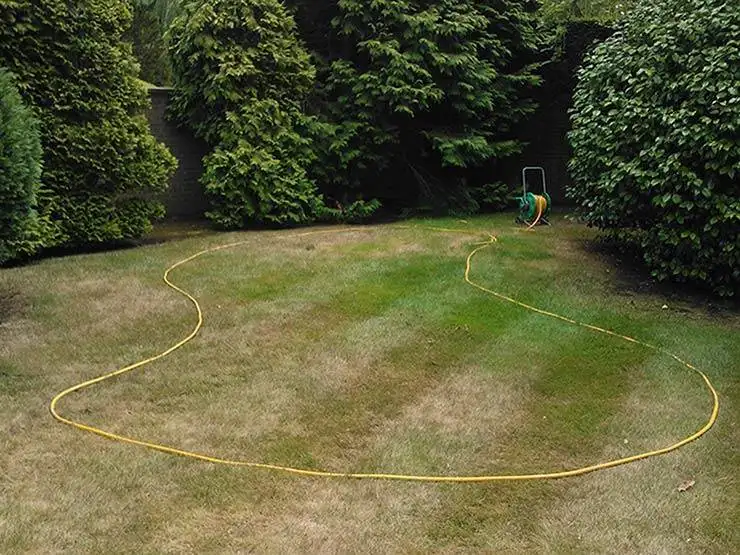
Selecting the Optimal Location
Choosing the right location is akin to selecting the heart of your landscape. Considerations span beyond aesthetics to practicalities like sunlight exposure, accessibility, and proximity to utilities. A well-chosen location ensures not just the visual appeal of the pond but also its functionality and ease of maintenance.
Determine the Ideal Size and Shape
The size and shape of the pond are critical considerations, balancing available space with aesthetic preferences. While a larger pond provides opportunities for diverse plant and animal life, smaller ponds can be charming focal points. The shape should harmonize with the landscape, creating a seamless integration with the surrounding environment.
Obtaining Necessary Permits
The regulatory landscape plays a pivotal role in pond construction. Before excavation begins, it’s essential to navigate local regulations, obtaining necessary permits to ensure compliance. Understanding water usage regulations, environmental impact assessments, and property boundaries is crucial in preventing regulatory hurdles down the line.
As one delves into the planning phase, the aim is not merely to lay the groundwork for construction but to cultivate a vision—a vision that respects the natural contours of the land, harnesses the power of sunlight, and integrates seamlessly into the fabric of the environment. Through meticulous planning, the pond takes shape not just as a physical entity but as a living, breathing extension of the landscape, promising a harmonious blend of form and function. In the subsequent stages, we will delve into the artistry of pond design, where creativity converges with ecological sensibilities to give rise to an oasis of beauty and balance.
Designing Your Pond
Designing a pond is a delicate balance of artistry and functionality, where the contours of the land merge with the vision of the creator to form a harmonious aquatic landscape.
Choosing the Type of Pond
The selection of the pond type sets the stage for the entire design process. Whether it’s a naturalistic pond blending seamlessly with the surroundings, a formal pond exuding elegance and symmetry, a wildlife pond teeming with biodiversity, or a koi pond showcasing ornamental fish, the choice reflects the intended purpose and aesthetic preferences.
Creating a Detailed Pond Design
The design phase brings the vision to life, incorporating elements such as layout, features, and aquatic plant placement. It involves careful consideration of water circulation patterns, depths, and contours to ensure optimal habitat conditions for aquatic life. The layout should strike a balance between functional considerations and aesthetic appeal, creating a visually captivating landscape that integrates seamlessly with the surrounding environment.
Selecting Appropriate Pond Materials
The selection of pond materials is crucial for durability, aesthetics, and ecological compatibility. From liners that prevent water seepage to rocks and substrates that enhance natural beauty, each material choice contributes to the overall integrity and sustainability of the pond. Considerations such as material longevity, environmental impact, and maintenance requirements guide the selection process.
As the design takes shape, it becomes a manifestation of creativity and ecological consciousness—a testament to the delicate balance between human intervention and natural harmony. In the subsequent stages of pond construction, we will delve deeper into the technical aspects of excavation, installation, and landscaping, exploring the techniques and considerations that transform a vision into a living, breathing ecosystem.
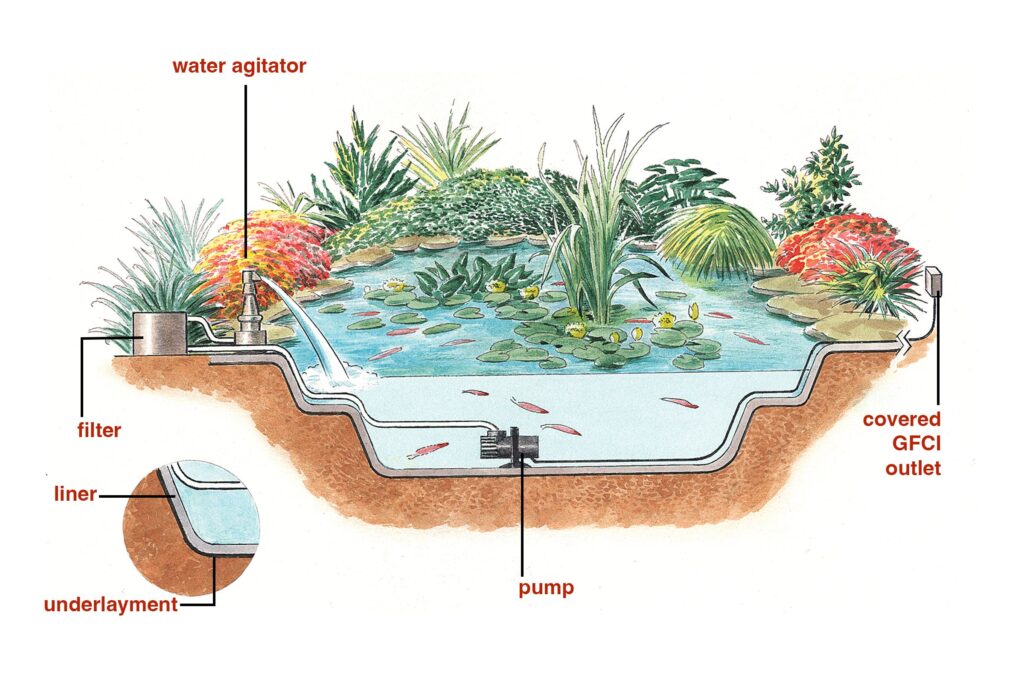
Excavating the Pond
Excavating the pond marks the transition from conceptualization to physical realization, as the landscape is sculpted to accommodate the aquatic habitat.
Marking the Pond Perimeter
Precision is paramount when marking the perimeter of the pond. Using stakes and string, the boundaries are defined, outlining the desired shape and dimensions. This step ensures accuracy and provides a clear guide for excavation.
Excavating the Pond
Excavation is a labor-intensive process that requires careful planning and execution. Using excavators or manual labor, the soil is removed to the desired depth, creating the foundation for the pond. Attention to detail is crucial to achieving the desired contours and slopes that facilitate water circulation and plant growth.
Creating Shelves and Slopes
The creation of shelves and slopes adds depth and dimension to the pond, providing niches for aquatic plants and habitat for wildlife. Shelves offer staging areas for marginal plants, while gentle slopes provide access for amphibians and other aquatic creatures. These features enhance the ecological diversity and aesthetic appeal of the pond.
Excavation is a transformative stage in the pond-building process, where the landscape undergoes a metamorphosis, evolving from a blank canvas to a dynamic aquatic environment. As the soil is sculpted and the contours take shape, the pond begins to embody the vision and promise of its creator. In the subsequent phases, we will explore the installation of pond equipment and the delicate art of landscaping, as we bring the aquatic oasis to life.
Installing Pond Equipment
Installing pond equipment is a critical step that ensures the functionality and long-term health of the aquatic ecosystem.
Adding a Pond Liner
The pond liner forms the foundation of the aquatic habitat, preventing water seepage and maintaining the structural integrity of the pond. Selecting a high-quality liner that is durable and puncture-resistant is essential for ensuring the longevity of the pond.
Installing a Filtration System
A filtration system is indispensable for maintaining water clarity and quality. It consists of pumps, filters, and skimmers that work together to remove debris, excess nutrients, and harmful pathogens from the water. Proper filtration is essential for creating a healthy environment conducive to aquatic life.
Incorporating Aeration Features
Aeration features such as waterfalls, fountains, or aerators play a crucial role in oxygenating the water and promoting gas exchange. They help maintain optimal oxygen levels, prevent stagnation, and create a dynamic water environment that supports aquatic life. The installation of aeration features enhances water quality and promotes ecosystem balance.
The installation of pond equipment represents the technical backbone of the aquatic habitat, ensuring that essential functions such as water circulation, filtration, and aeration are optimized for the well-being of the pond ecosystem. In the subsequent stages of pond construction, we will explore the process of adding water, landscaping the surroundings, and establishing the delicate balance of plant and animal life within the pond environment.
Adding Water and Landscaping
Adding water and landscaping are pivotal stages in transforming the excavated site into a vibrant and harmonious aquatic habitat.
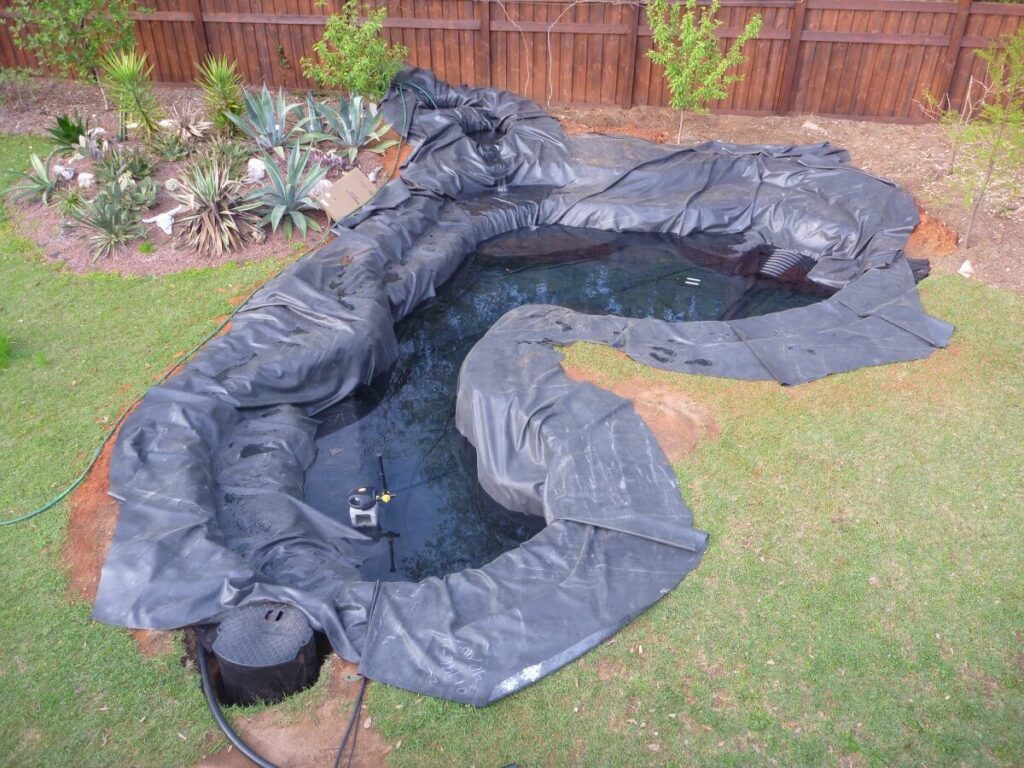
Filling the Pond with Water
Filling the pond marks the moment when the vision begins to materialize. The pond is filled with water, sourced from a nearby water supply or collected rainwater. As the water level rises, the pond comes to life, reflecting the surrounding landscape and inviting exploration.
Landscaping Around the Pond
Landscaping around the pond enhances its aesthetic appeal and ecological function. Rocks, plants, and decorative elements are strategically placed to create visual interest and provide habitat for wildlife. Native plants are selected for their adaptability and ability to attract beneficial insects and birds, contributing to the overall biodiversity of the ecosystem.
Creating a Habitat
Incorporating features that mimic natural habitats enhances the ecological diversity of the pond. Rocks, logs, and submerged plants provide shelter and breeding sites for fish and amphibians, while floating vegetation offers refuge for insects and other aquatic organisms. Creating a diverse habitat ensures the long-term health and resilience of the pond ecosystem.
As water fills the pond and the landscape takes shape, the vision of a tranquil oasis becomes a reality. Each element, from the glistening water to the lush vegetation, contributes to the beauty and functionality of the pond ecosystem. In the subsequent phases of pond construction, we will explore the process of establishing and maintaining the pond, ensuring its vitality and sustainability for years to come.
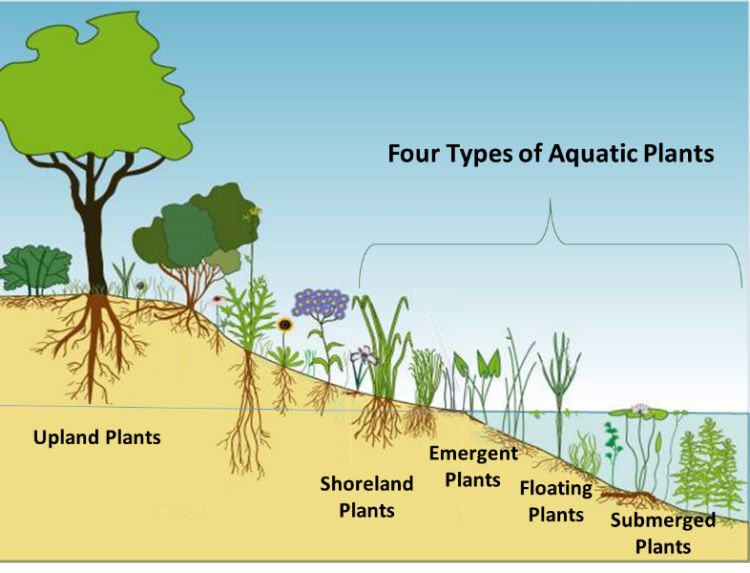
Establishing and Maintaining Your Pond
Establishing and maintaining your pond is essential for ensuring its long-term health and vitality.
Introducing Aquatic Plants and Fish
Aquatic plants play a crucial role in maintaining water quality and providing habitat for fish and other aquatic organisms. Native species are preferred for their adaptability and ability to thrive in the local environment. Fish, such as koi or goldfish, add movement and color to the pond while contributing to its ecological balance.
Monitoring Water Quality Parameters
Regular monitoring of water quality parameters, such as pH, ammonia levels, and dissolved oxygen, is essential for maintaining a healthy pond ecosystem. Testing kits are used to assess water quality and identify any imbalances or potential issues that may arise. Adjustments can be made as needed to ensure optimal conditions for aquatic life.
Performing Routine Maintenance
Routine maintenance tasks, such as removing debris, trimming plants, and cleaning filters, are necessary for keeping the pond clean and functioning properly. Regular inspection of equipment and infrastructure helps identify any issues early on and prevent potential problems from escalating. By staying proactive with maintenance, you can preserve the beauty and functionality of your pond for years to come.
Establishing and maintaining your pond requires dedication, patience, and a commitment to environmental stewardship. By fostering a balanced ecosystem and embracing sustainable practices, you can create a thriving aquatic habitat that enriches your landscape and provides a sanctuary for wildlife. In the subsequent phases of pond construction, we will explore troubleshooting and problem-solving techniques to address common issues and ensure the continued health and vitality of your pond ecosystem.
Troubleshooting and Problem Solving
Addressing potential challenges and resolving issues is an integral part of pond ownership, ensuring the long-term health and sustainability of the aquatic ecosystem.
Identifying and Addressing Potential Challenges
Common challenges in pond management include algae blooms, water clarity issues, leaks, and invasive species. By carefully observing the pond environment and monitoring water quality parameters, you can identify potential issues early on and take proactive measures to address them.
Implementing Effective Solutions
Effective solutions to common pond problems include adding additional filtration, adjusting water chemistry, and implementing biological controls for algae and pest species. Solutions should be tailored to the specific needs and characteristics of your pond ecosystem, taking into account factors such as water volume, plant and animal species present, and environmental conditions.
Seeking Professional Assistance
In some cases, resolving pond issues may require professional expertise and specialized equipment. Consulting with a pond maintenance professional or aquatic biologist can provide valuable insights and recommendations for addressing complex problems and restoring the health and balance of the pond ecosystem.
By staying vigilant and proactive in addressing pond challenges, you can ensure that your pond remains a vibrant and sustainable ecosystem that enhances the beauty of your landscape and provides a habitat for diverse plant and animal life. In the subsequent phases of pond construction, we will explore strategies for enjoying and maximizing the benefits of your pond while fostering a deeper connection with nature.
Enjoying Your Pond
After the careful planning, construction, and maintenance, it’s time to reap the rewards of your efforts by enjoying the beauty and tranquility of your pond.
Relaxing and Enjoying the Tranquil Ambiance
Take the time to sit by your pond and immerse yourself in its peaceful ambiance. Listen to the gentle sounds of water and wildlife, feel the soothing breeze, and allow yourself to unwind and reconnect with nature.
Engaging with Wildlife
Observe the diverse array of wildlife that is attracted to your pond, from colorful fish swimming gracefully to frogs croaking in the evening. Appreciate the interconnectedness of life and the delicate balance of the ecosystem that your pond supports.

Sharing the Pond Experience
Invite family, friends, and neighbors to share in the beauty of your pond. Host gatherings, picnics, or educational workshops to foster a sense of community and appreciation for nature. Share your knowledge and passion for pond ownership with others, inspiring them to create their own aquatic oasis.
By embracing the joys of pond ownership and sharing the experience with others, you can create lasting memories and cultivate a deeper connection with the natural world. Your pond becomes more than just a landscape feature—it becomes a sanctuary of beauty, tranquility, and biodiversity that enriches your life and the lives of those around you.
